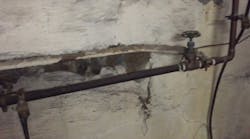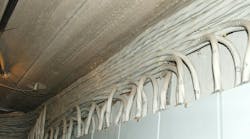As usual, never consider the following commentary associated with these photos as a formal interpretation of the National Electrical Code (NEC). Without criticizing anyone or any product, the following scenarios present us with serious safety questions.
All references are based on the 2005 NEC.
Definition of Overkill
David M. Swyter, owner of Swyter Electric in Reading, Mass., was kind enough to share this photo with us. “I could not identify a classified area within the vicinity of this equipment, but you never know,” says Swyter. “Maybe they just had money to burn — no pun intended.”
The use of this “explosionnproof apparatus” in this location seems like overkill. What good will it do since the other electrical material and fittings in this area are not of that type? The areas defined for Class I, Divisions 1 and 2 can be found in 500.5 of the Code. In addition, this definition can be found in 500.2 and Art. 100.
“Explosionproof Apparatus. Apparatus enclosed in a case that is capable of withstanding an explosion of a specified gas or vapor that may occur within it and of preventing the ignition of a specified gas or vapor surrounding the enclosure by sparks, flashes, or explosion of the gas or vapor within, and that operates at such an external temperature that a surrounding flammable atmosphere will not be ignited thereby.
“FPN: For further information, see ANSI/UL 1203-1999, Explosion-Proof and Dust-Ignition-Proof Electrical Equipment for Use in Hazardous (Classified) Locations.”
Is Anything Acceptable Here?
Ralph Koal, a master electrician with Grays Harbor PUD No. 1, Aberdeen, Wash., passed along this image he received from an employee at Star Electric. “The landlord didn't understand why we would not energize this service to her rental unit (her 80-year-old mom lived there!),” says Koal. “Are there enough violations here for you?”
All of the electrical fire and shock hazards present at this location can be identified as electrical violations or defects. This list gets pretty long in a hurry. For a few electrical hazards, we can cite the exposed live wires, the pigtail lampholders that were used to replace the damaged fuseholders, and the Edision base 30A fuses (those tampered with are not permitted for regular branch circuits) — not to mention the cabinet is a rusty bucket! See 110.2, 240.51, 240.52, 240.53, and 240.54.
Found a Code Violation? E-mail your photos to Joe Tedesco at [email protected].





